Before we get to the trike…
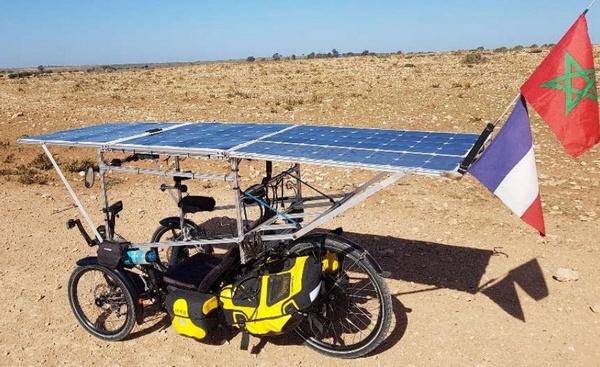
When I learned of the plan to organize the first Sun Trip to Astana in Kazakhstan in 2013, finding the adventure interesting, I rushed to register. Unfortunately, the registrations being closed, it is with great frustration that I followed the adventure on the Internet. I took the opportunity to observe the different bikes used in order to choose my next solar mount. One of the competitors, among the first to arrive, had an upright bicycle, with a motor in the front wheel and a “Christian Touzet” trailer supporting a solar panel. I copied, identically, this assembly to make my first solar bike and participate, in 2015, in the 2nd great adventure Sun Trip to Turkey.
Having no experience in assembling my solar bike, I went to Déclic’Eco by bringing Guillaume Devot a “hiker” bike that I had bought for this project and informing Guillaume about the assembly that I wanted… Guillaume had participated, with his wife, in the Sun Trip 2013 and his first good advice was to tell me: “You arrive with a new bike when you already have a travel bike. You are used to it then it is this bike that you need for this great Sun Trip and not a new bike that you do not know and which risks, over the kilometers, not being suitable for you”. So I left with this new bike and it was my old travel bike, with which I had covered thousands of kilometres, which was electrified.
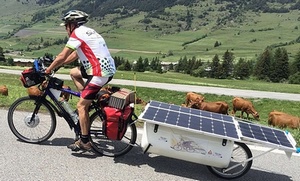
It was my old Motobécane mountain bike, very solid, front fork with metal springs but well modernized in its cycle part. Guillaume has mounted a reduced motor there, on a new and very solid front wheel with a steel front fork, unfortunately without shock absorbers so that it can absorb the torque of the motor. This will be the only modification on the bike, and at a lower cost. On the “Christian Touzet” trailer, a 200 Wp tilting solar panel has been attached.
The whole being managed by a controller and two Cycle Analyst V3: one for managing the motor’s electrical consumption with a potentiometer to adjust the motor’s power as needed and the other Cycle Analyst for managing the solar charging. So I had before my eyes, in real time, the energy expenditure and recharge. During the whole Sun Trip to Turkey, I had no mechanical or electrical problems and I never used the battery charger which has remained sealed since the start. My geared motor did the job well and I was able to climb all the mountains.
Nevertheless, two major drawbacks appeared: firstly, a major pain in the buttocks when arriving in Turkey and very poor ride comfort, from the start, due to this solid steel fork which sent me back, in my arms, all road faults. Along the way, observing the other solar bikes, I quickly understood that the best comfort for long-distance adventure was the “recumbent” position and, in particular, a trike to pedal in the shade of a large solar panel roof. As soon as I returned, I therefore embarked on the project of a solar trike.
As for the “Christian Touzet” trailer, this one is perfect. Entirely in fiberglass, it is very light, has very good road holding, completely waterproof, with a good volume of lockable load. Its only drawback is its very expensive price (1000€ in 2015 and much more today…). Nevertheless, this trailer benefits from a very good return on investment since, after tens of thousands of kilometres, on any terrain, it is in perfect condition… I abandoned my trailer for the sole reason of lightening my luggage and reduce my wheelbase, on the road. I have forced myself to reduce the rolling weight, which is very penalizing for the cyclist, especially on big mountain climbs.
Technical presentation
Bike
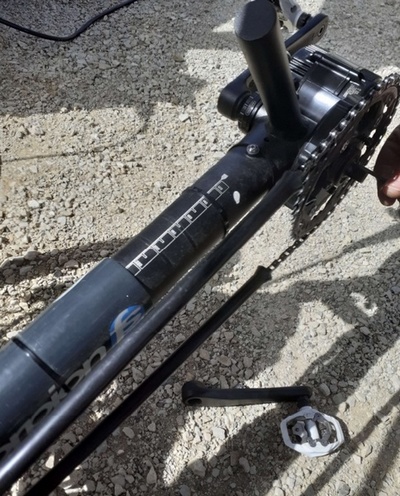
- HP Velotechnik model Trike FS 26
- 2 front wheels in 20 inches and one rear wheel in 26 inches, with suspension on the front and rear wheels
- with brakes Shimano mechanical disc on all three wheels, three brake handles with stationary wheel locking system
- Schwalbe “Big Appel” 20″ tires at the front, Schwalbe “Marathon plus-Tour” tire ” in 175 on the rear wheel.
Transmission: - reinforced chain line with intermediate pulley. The chain, always in line straight, works without wear.
- crankset with 2 chainrings in 42 and 36 teeth, by adding a Rohloff chain tensioner Easy derailment, by hand (derailleur difficult to install with the Bafang crankset motor)
- 8-speed rear cassette in 11-40 with Shimano large cage derailleur
- Shimano pedals with SPD cleats
- “grand raid” rear rack and mudguards on the three wheels
- bag Ortlieb pockets and luggage
- lighting: powerful white LED headlight at the front, powerful red LED headlight, fixed or flashing, at the rear, powered by the bicycle battery
- accessories: 2 5V transformers for powering smartphones and GPS, 1 12V transformer with “cigarette lighter” socket.
Motorization
Installation of 2 motors:
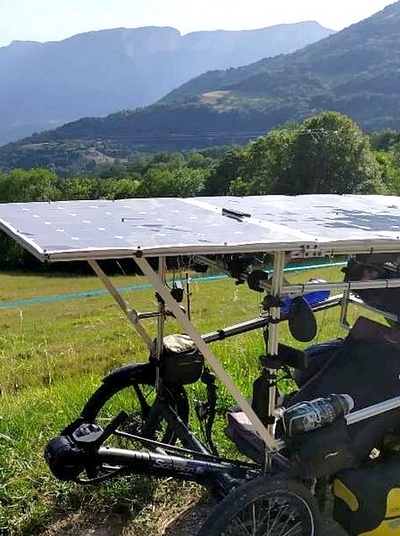
- 1 rear wheel motor, Nine Continent RH212, Direct Drive, powered by 48 Volts. Management: Baserunner Grin Tech 3 controller combined with a Cycle Analyst V4, button to vary the engine power as needed, start trigger on the handlebars, regeneration controlled by brake lever.
- 1 Bafang crankset motor BBS02 750w, powered by 48 Volts. Management: controller and pedaling sensor integrated in the motor, display and control console allowing the power to be varied as needed (9 levels), starter trigger on the handlebars. The two motors can work together or separately (2 independent installations).
Battery
- 2 x 48V 11Ah batteries (1056 Wh total capacity)
- 1 x 48V 30Ah backup battery (1440 Wh capacity).
Solar equipment
- 3 solar panels for a total of 370 Wp, i.e.: 2 panels of 110 Wp each on the front and 1 panel of 150 Wp on the back
- roof mounting, on a chassis made of aluminum profiles, Systea brand, also acting as an additional rear luggage rack.
- an MPPT solar regulator, 48 Volts, for the two front panels, total of 220W
- a Genasun MPPT solar regulator, in 48 Volts for the rear panel of 150Wp
- a Cycle Analyst V3 for the global management of solar charging.
Comments
Why 2 motors?
The RH212 Direct Drive rear wheel motor is an excellent motor, reliable, quiet, responsive and durable. Its only flaw is that it gets very hot and excessively hot on severe long climbs when mounted on a 26-inch wheel. If it were mounted on a 20-inch wheel, the RH212 would turn faster, its performance would be much better, it would heat up less. On a 26-inch wheel, the addition of the Statorade “anti-heating” product had no noticeable effect.
On the other hand, aided by a second motor on steep slopes, the RH212 motor heats up less and I have noticed a lower total power consumption for both motors. The big climbs of the high passes no longer pose any problem with the two engines, especially since the Bafang engine benefits from much greater traction than the RH212 engine. On flat or hilly courses, I only use the RH212 rear motor. On descents, the RH212 engine can be switched to regeneration mode, which allows you to less tense up on the brakes and recharge the battery.
The entire motorization and electronics part was assembled at Déclic’Eco, whose seriousness, experience and professionalism have largely proven themselves, in addition to the flawless “after-sales” service.
At the purchase, the HP Velotechnik trike represents a big investment but it is one of the best on the market due to its solidity, its reliability and its comfort. Over time we find ourselves there. I bought it in 2016 and, to date, after having traveled more than 15,000 km, it is still in perfect condition.
Feedback
Its chassis and road qualities, with its cycle part, are excellent. To this must be added its steering system, identical to that of a car, with an anti-roll bar which ensures good stability in addition to the steering rods for driving precision.
During our Sun Trips, our bikes are often fully loaded. I therefore chose front (elastomer system in a spring) and rear (spring) suspensions as well as the anti-roll bar in “hard” mode which ensures perfect comfort and road holding.
The frame supporting the solar panels is perfectly square. It allows you to fix all the electrical driving elements, the Cyclanalist and some small additional bags. Everything is within reach and in sight, in addition to the attachment of the water canisters. The choice of the panels on the roof allows their total exposure to the sun in addition to the great advantage of pedaling in the shade.
When stationary, the entire trike can be tilted by resting on a support (ski pole) in order to orient all the panels towards the sun, which optimizes solar charging.
In along the way, the panels are fixed and horizontal. I did not choose the tilting mode for reasons of solidity and to avoid a possible failure of the system. In addition, the length of the assembly (2.65 m long by 82 cm wide) would have required an overly complicated tilting system. My bike is a complete machine. Since its purchase, in 2016, during all these years spent driving, over thousands of kilometers, on all types of terrain; this time allowed the finality of its adaptation to long-distance travel without worries and in complete reliability.
I am fully satisfied with my solar trike which is always ready for a next long-distance trip.
Next solar bike
Although completely satisfied with my solar trike, which is now completely finished, it turns out that I have done the trick. I want to embark on a new technical adventure.
My choice will be a two-wheel recumbent bike, still HP Velotechnik brand, “Speed Machine” model with U-shaped handlebars, to attach the instruments driving and motor and solar management. I’ll choose a GrinTech motor, with regenerative, mounted in the 20-inch front wheel. The rear wheel will be mounted with the Rohloff hubs that fitted my first solar bike! In case of overheating in the mountains, I will add a reduced motor in the 26 inch rear wheel. I will not choose a pedal motor which risks unbalancing the balm, by its weight and its poor aesthetics for a recumbent two-wheeler.
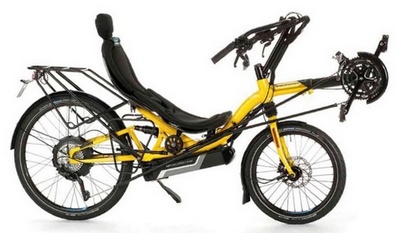
I will have two batteries of 1 kWh each, connected in parallel (i.e. a total of 2000 Wh onboard). They will be fixed, at the lowest, in a luggage rack, under the driver’s seat.
For solar, I will opt for 2 panels with a total power of 250 to 300 Wp. They will be mounted on the roof, of small width and at minimum height. I have not yet decided whether I will adopt the tilting mode or not, without making a “gas plant” to maneuver it.
The solar panels and battery elements are split in two so that in the event of a breakdown, on one of the two elements, the other continues to operate and thus allows you to continue your journey…
Why choose a recumbent two-wheeler?
I want to learn about recumbent cycling. I have never had or tried. The pedaling position of the “Speed machine” model is very close to my trike of the same brand. This two-wheeled recumbent bike will be lighter than my trike, more rolling but its luggage carrying capacity will be reduced. It will be a new discovery, a new experience and a new project to carry out.
